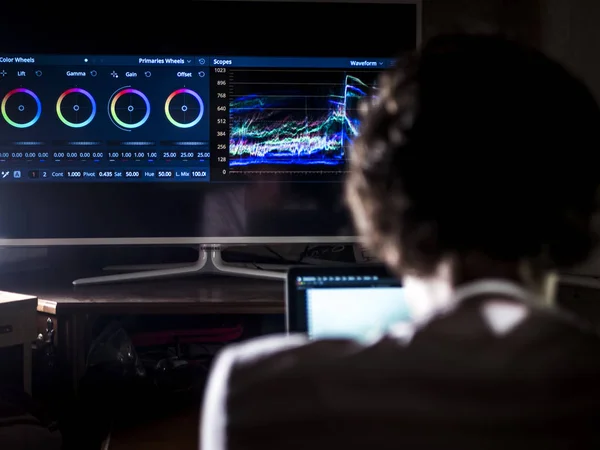We at Lucidity Pictures are preparing to enter one of the most intricate and fascinating phases of filmmaking—post-production. This stage will last through the summer and involves five major elements, each requiring expertise, precision, and artistry.

While many people think of post-production as simply editing, it’s far more complex. It’s where the raw footage transforms into a polished, immersive experience—where color, sound, music, and animation come together to create the final product.
Step 1: Picture Lock – The Foundation of the Film
The first and most critical step in post-production is achieving picture lock. This means finalizing the structure of the documentary—the sequence of shots, the pacing, the transitions—all without any further changes to the edit. While this is sometimes called a “rough cut,” by the time we reach picture lock, every shot, interview, and visual element has been meticulously placed.
At this stage, nothing is colored, the music is temporary, and raw sound remains unpolished. However, timing is locked in, which allows the other post-production departments to begin their work.
Once picture lock is complete, four different post-production processes begin simultaneously:
Step 2: Color Grading – Bringing Visuals to Life

A colorist will take the final cut and refine its look. This process, called color grading, enhances the mood, tone, and consistency of each scene. Every shot is carefully balanced to ensure that skin tones look natural, that colors remain consistent between different cameras and lighting conditions, and that the visuals match the emotion of the story.
In Cradled in Glass, we have a wide range of footage—clinical settings, interviews, outdoor landscapes, and dramatic re-enactments. The colorist will create a seamless visual style that unifies the documentary, ensuring that it looks both cinematic and professional.
Step 3: Scoring – The Composer & Director’s Collaboration
Simultaneously, our composer will begin writing and recording the musical score. Composers don’t start working until picture lock because they need to match the music perfectly to the timing of each scene.
The process begins with “spotting,” where the composer and director watch the film together, deciding where music should be placed and what emotions it should evoke. The director’s input is crucial—this collaboration ensures that the music complements the storytelling rather than overpowering it.
Once the composer writes the score, live musicians will record the music, which is then mixed and refined in the studio. The director will often sit in on recording sessions, working closely with the composer to fine-tune details, ensuring the score enhances the emotional depth of each moment.
Step 4: Sound Editing – Refining Every Detail
While music and color grading are in progress, the sound editing house will be working on all the dialogue, background noise, and environmental sounds. Their job is to ensure that voices are crisp, background noise is removed, and all sound levels are balanced for a professional, immersive experience.
This step is especially important for Cradled in Glass, as many of our interviews were filmed in various settings with different acoustics. The sound editors will make sure every word is clear and impactful.
Step 5: Scientific & Medical Animation – Visualizing the Invisible
One of the most exciting aspects of Cradled in Glass is our high-quality scientific and medical animations, created by The Mad Micro. This studio specializes in cinematic, photorealistic animations that will allow viewers to see the unseen—the microscopic processes involved in in vitro fertilization.
Rather than relying solely on interviews to describe these complex procedures, The Mad Micro’s animations will bring the science to life, helping audiences understand what is happening at a cellular level. We highly recommend checking out their showreel—their work is nothing short of breathtaking.
Final Sound Engineering & Foley – Creating the Sounds You Can’t Hear
Once the animations are finished, the sound editing house will move on to the final phase of sound design and Foley. While dialogue and natural sounds are already cleaned up, some sounds simply don’t exist in reality—or cannot be recorded in the moment.
For example, consider the sound of a needle piercing an egg cell. That process is microscopic, meaning there’s no actual sound to record. Instead, sound engineers must invent the sound, using creative recording techniques and digital effects.
Foley artists might create similar effects for other moments in the film, using unexpected materials to mimic real-world sounds—such as pressing a leather glove to simulate a heartbeat or tapping on a thin membrane to replicate microscopic punctures.
This is where Cradled in Glass becomes fully immersive, with every visual paired with an auditory experience that makes it feel real.
Final Assembly – Bringing It All Together
Once the composer has finished the score, the animation studio has delivered the final visuals, and sound editing is complete, the sound house will combine everything—dialogue, sound effects, Foley, music, and ambient audio—into a seamless final mix.
At this point, Cradled in Glass will finally be ready for distribution.
The Road Ahead
Post-production is an intricate, multi-step process that requires collaboration across several teams. By the end of the summer, Cradled in Glass will transform from a collection of footage into a powerful, polished documentary that we can’t wait to share.
If you’d like to support the final stages of production, Lucidity Media Corp. currently has investment opportunities available. For inquiries, please contact scrossfield@luciditypictures.com.
Thank you for following our journey—stay tuned for more updates as we bring Cradled in Glass to life!
For truth,
The Lucidity Pictures Crew
